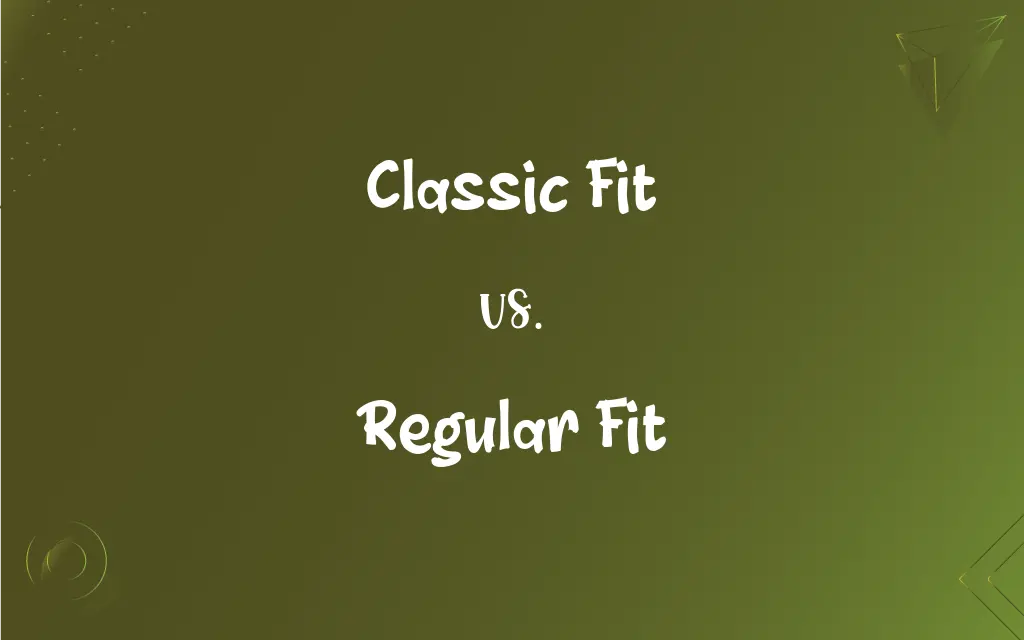Classic Fit vs. Regular Fit: What's the Difference?
Edited by Aimie Carlson || By Harlon Moss || Published on January 25, 2024
Classic fit offers a more generous cut with extra room, ideal for comfort and traditional style, whereas regular fit is moderately tailored, balancing comfort and a modern silhouette.

Key Differences
Classic fit clothing is designed for comfort and ease of movement, often featuring a looser cut. Regular fit, in contrast, provides a more tailored silhouette that's not too tight nor too loose, offering a contemporary look.
The classic fit is ideal for those who prefer a traditional, timeless style with more room around the chest and waist. Regular fit offers a slightly closer fit to the body, suitable for a range of body types, without being restrictive.
In classic fit garments, the armholes and sleeves are cut larger for a more relaxed feel. Regular fit clothing tends to have moderately sized armholes and sleeves, providing a balance between ease of movement and a streamlined appearance.
Classic fit is often chosen for formal wear like suits and dress shirts, providing a dignified, roomy feel. Regular fit is versatile, commonly seen in both casual and formal attire, appealing to those who seek a modern, fitted look.
The classic fit is a preference for those who prioritize comfort and traditional styling in their wardrobe. Regular fit is the go-to for those aiming for a smart, adaptable style that fits well in various social and professional settings.
ADVERTISEMENT
Comparison Chart
Cut
Generous, looser
Moderately tailored, not too tight
Style
Traditional, timeless
Contemporary, modern
Fit Around Chest and Waist
Roomier for comfort
Closer to the body, balanced
Sleeve and Armhole Size
Larger, more relaxed
Moderate, for ease and shape
Ideal Usage
Formal wear, prioritizing comfort
Versatile for casual and formal
ADVERTISEMENT
Classic Fit and Regular Fit Definitions
Classic Fit
Features more room around the chest and waist.
The classic fit shirt was perfect for a comfortable, relaxed day at the office.
Regular Fit
A modern, tailored fit that's not too tight.
His regular fit jeans were stylish yet comfortable for everyday wear.
Classic Fit
Larger armholes and sleeves for a relaxed feel.
The classic fit of his jacket made it an excellent choice for long meetings.
Regular Fit
Streamlined appearance with moderate ease of movement.
The regular fit of his polo shirt was ideal for both golfing and lunch meetings.
Classic Fit
Emphasizes traditional styling and ease.
His preference for classic fit clothing reflected his love for traditional fashion.
Regular Fit
Balances comfort with a contemporary silhouette.
The regular fit blazer was perfect for a smart-casual look.
Classic Fit
Ideal for formal wear, offering a dignified appearance.
He chose a classic fit tuxedo for its timeless elegance.
Regular Fit
Offers a modern look in both casual and formal attire.
For his job interview, he chose a regular fit suit to look modern and professional.
Classic Fit
A traditional, looser cut for maximum comfort.
His classic fit suit allowed for easy movement throughout the event.
Regular Fit
Moderate room around the body, suitable for various body types.
He preferred regular fit shirts for their versatile and flattering fit.
FAQs
How does regular fit differ from classic fit?
Regular fit is more tailored, offering a balance between comfort and a modern look.
What defines a classic fit?
Classic fit is a looser, more generous cut for comfort and traditional style.
Is classic fit suitable for formal occasions?
Yes, classic fit is often preferred for formal wear due to its dignified appearance.
Can regular fit be worn casually?
Absolutely, regular fit is versatile for both casual and formal settings.
Who should choose classic fit clothing?
Those who prioritize comfort and a timeless style.
How does regular fit look on a slim body?
It looks well-proportioned and neat, offering a contemporary silhouette.
Are classic fit trousers wider?
Yes, they typically have a wider cut for comfort.
Is regular fit flattering for all body types?
Yes, its balanced cut is suitable for a wide range of body shapes.
Can classic fit be stylish?
Certainly, it offers a traditional and sophisticated style.
Is regular fit good for professional attire?
Yes, its modern tailoring is ideal for professional settings.
Does classic fit mean oversized?
Not necessarily oversized, but it's definitely roomier than regular fit.
Can I find classic fit in modern brands?
Yes, many brands offer classic fit options in their collections.
Does regular fit come in different styles?
Yes, it's available in a range of styles, from casual to formal.
Can classic fit be too loose?
It might feel looser than contemporary fits, depending on personal preference.
Is regular fit suitable for athletic builds?
Yes, it can accommodate and flatter an athletic physique.
Are classic fit shirts roomier?
Yes, they offer more room, especially around the chest and waist.
Does regular fit restrict movement?
No, it provides a comfortable balance between fit and movement.
How do armholes differ in regular fit?
They are moderately sized, balancing comfort and shape.
Is classic fit better for older generations?
It's often preferred, but it's not limited to any specific age group.
Is regular fit the same as slim fit?
No, regular fit is less tailored than slim fit, offering more room.
About Author
Written by
Harlon MossHarlon is a seasoned quality moderator and accomplished content writer for Difference Wiki. An alumnus of the prestigious University of California, he earned his degree in Computer Science. Leveraging his academic background, Harlon brings a meticulous and informed perspective to his work, ensuring content accuracy and excellence.
Edited by
Aimie CarlsonAimie Carlson, holding a master's degree in English literature, is a fervent English language enthusiast. She lends her writing talents to Difference Wiki, a prominent website that specializes in comparisons, offering readers insightful analyses that both captivate and inform.































































